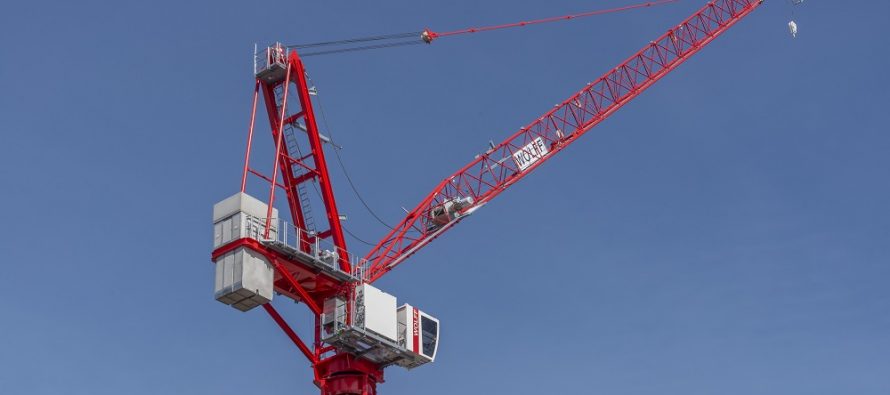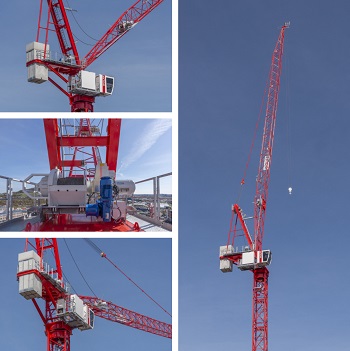The WOLFF 235 B – New dimensions in assembly and maintenance

Related Articles
Time is money. On construction sites, this not only applies to the performance of a crane, but also to its assembly and maintenance characteristics. The faster a crane is ready for operation, the more cost-effective it is. This premise was the top priority when developing the new WOLFF 235 B. In terms of performance, it replaces the popular WOLFF 224 B and ranks between the hydraulic WOLFF 166 B and the next larger WOLFF 275 B in the lower load moment range, thus fulfilling the demands of construction sites with a high volume of concreting work on high-rise buildings.
“The WOLFF 235 B was developed in close collaboration with WOLFFKRAN customers from the UK, who have decades of experience in handling luffing cranes on inner-city construction sites. The result is a WOLFF with a proven duty chart that is unrivaled when it comes to assembly and versatility,” says Wouter van Loon, Product Manager at WOLFFKRAN.
Its assembly characteristics are its true strength
Although WOLFF cranes are generally easy to assemble, the manufacturer has raised the bar to yet another level with its latest model. As a result, the hoisting gear of the new WOLFF 235 B is positioned on the jib rather than the counter jib as is typical. “This makes it possible to reeve the hoisting rope on the ground and thus completely pre-assemble the entire jib,” explains Wouter van Loon and adds: “As well as being very convenient and safe, it is also a novelty for luffing jib cranes of this size.”
 The luffing gear can be mounted either on the counter jib or on the tower top during the assembly process, which offers more flexibility with regard to the size of the mobile crane. The second option has the advantage that the entire tower top including the hoisting gear with pre-reeved pulley block can be transported and lifted onto the crane as a single unit, which is an enormous time-saver. “In addition, the cabin platform with the WOLFF Cab and switch cabinet can be placed on the empty counter jib during transportation,” says van Loon.
The luffing gear can be mounted either on the counter jib or on the tower top during the assembly process, which offers more flexibility with regard to the size of the mobile crane. The second option has the advantage that the entire tower top including the hoisting gear with pre-reeved pulley block can be transported and lifted onto the crane as a single unit, which is an enormous time-saver. “In addition, the cabin platform with the WOLFF Cab and switch cabinet can be placed on the empty counter jib during transportation,” says van Loon.
Further, overall low component weights ensure that a WOLFF 235 B can assemble another of its kind at a jib radius of 40 meters – a very popular process on multi-crane city sites where space is often an issue and also saving on time and money for a mobile crane.
Maintenance, set, go!
Another key aspect in the development of the WOLFF 235 B was the economical maintenance of the crane, which led to the decision to use an identical winch for both the hoisting and the luffing gear. WOLFFKRAN opted for the tried and tested 60 kW winch Hw 1160 FU that is used in numerous other WOLFF crane models, which is also the case for the slewing gear and the frequency converters that are used in the 235 B. Aside from integrating proven technology, this stands for economical warehousing as fewer different spare parts have to be stocked and also simplifies training of service technicians.
The same principle applies to the 8-tonne counterweight blocks that are used in all next larger WOLFF luffing jibs cranes. “It is also worth mentioning that the new WOLFF manages with only four counterweight blocks which means that only four lifts are required for the complete ballasting of the crane,” explains van Loon.
 Further features facilitating maintenance include the use of maintenance-free multi-disk brakes and the positioning of the luffing gear at the bottom of the tower top. The latter allows particularly convenient and safe access to the luffing gear from the counter jib. The slewing gear can be serviced from an auxiliary platform.
Further features facilitating maintenance include the use of maintenance-free multi-disk brakes and the positioning of the luffing gear at the bottom of the tower top. The latter allows particularly convenient and safe access to the luffing gear from the counter jib. The slewing gear can be serviced from an auxiliary platform.
At home in the city
The WOLFF 235 B offers a maximum load capacity of 8 tonnes in single-fall and 16 tonnes in 2-fall operation and jib lengths from 30 to 60 meters. Designed to deliver its best performance with a 50-meter jib, it outperforms its competition with a tip load capacity of 4.1 tonnes. Its efficient 60 kW hoisting winch allows for working speeds of up to 130 m/min and a rope storage capacity of 620 meters. That all makes it the ideal crane for high-rise construction with reinforced concrete. It comes with a connection to the 2-meter tower UV/TV 20 and can reach a maximum freestanding height of 82 meters using standard components from the modular WOLFF tower system.
Thanks to its active absorber, the WOLFF 235 B achieves a smaller minimum jib working radius of 10 percent of the jib length. The steeper jib position means that the load can be picked up closer to the tower, which is a particular advantage at cramped city construction sites, as trucks can be unloaded closer to the crane and loads do not have to be lifted over adjacent roads.
Top class crane control as standard
For the WOLFF 235 B, the proven WOLFF crane control has been enhanced with a brake testing function allowing the main and secondary brakes to be tested independently of each other. Further included as standard is the WOLFF Link remote diagnostic and maintenance tool with real-time display of the crane operator’s monitor, fine drive modes and automatic power optimization for the hoisting and luffing gear, an anti-collision interface, as well as the WOLFF Boost function increasing load capacity by 10 percent.







